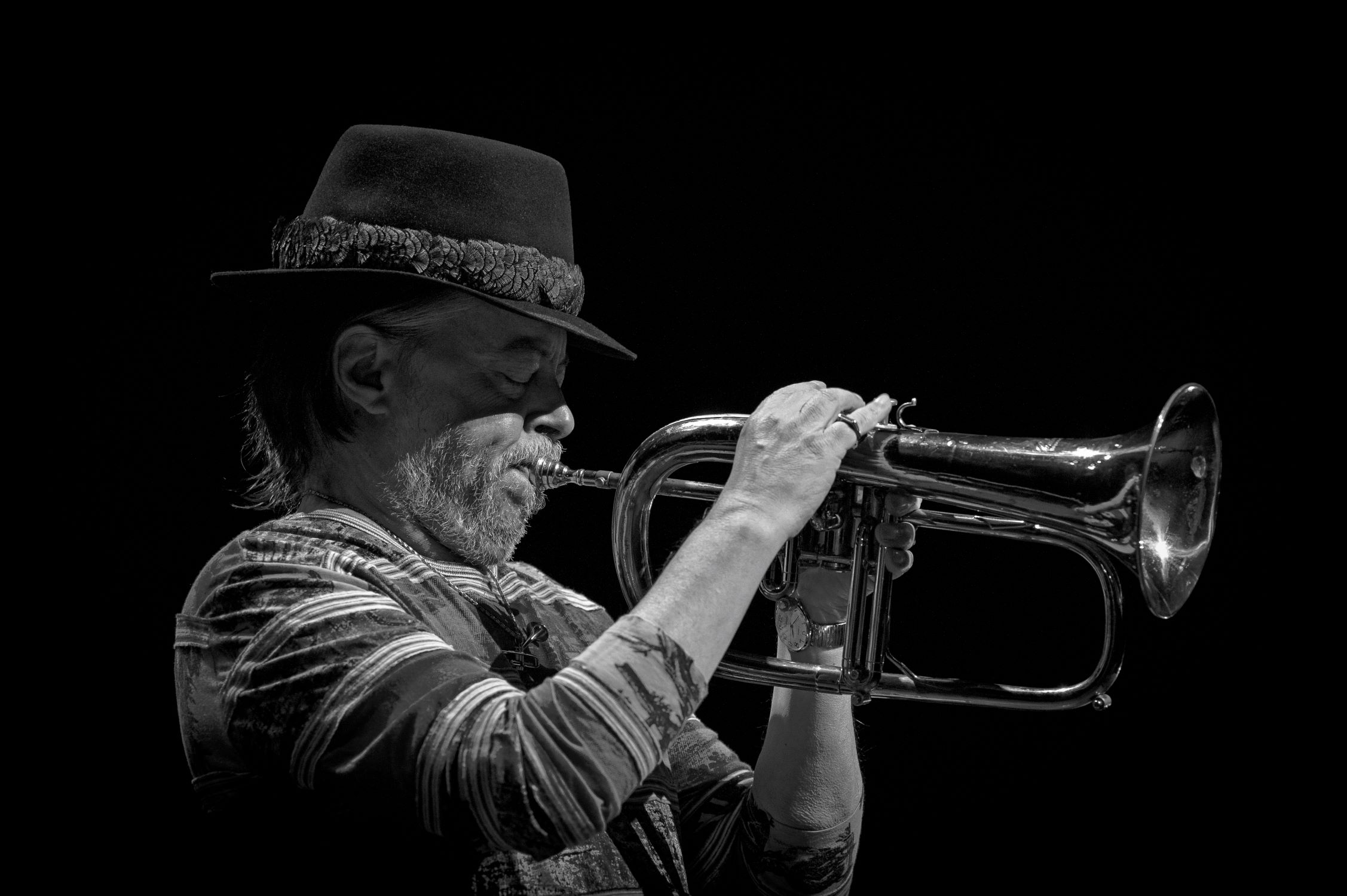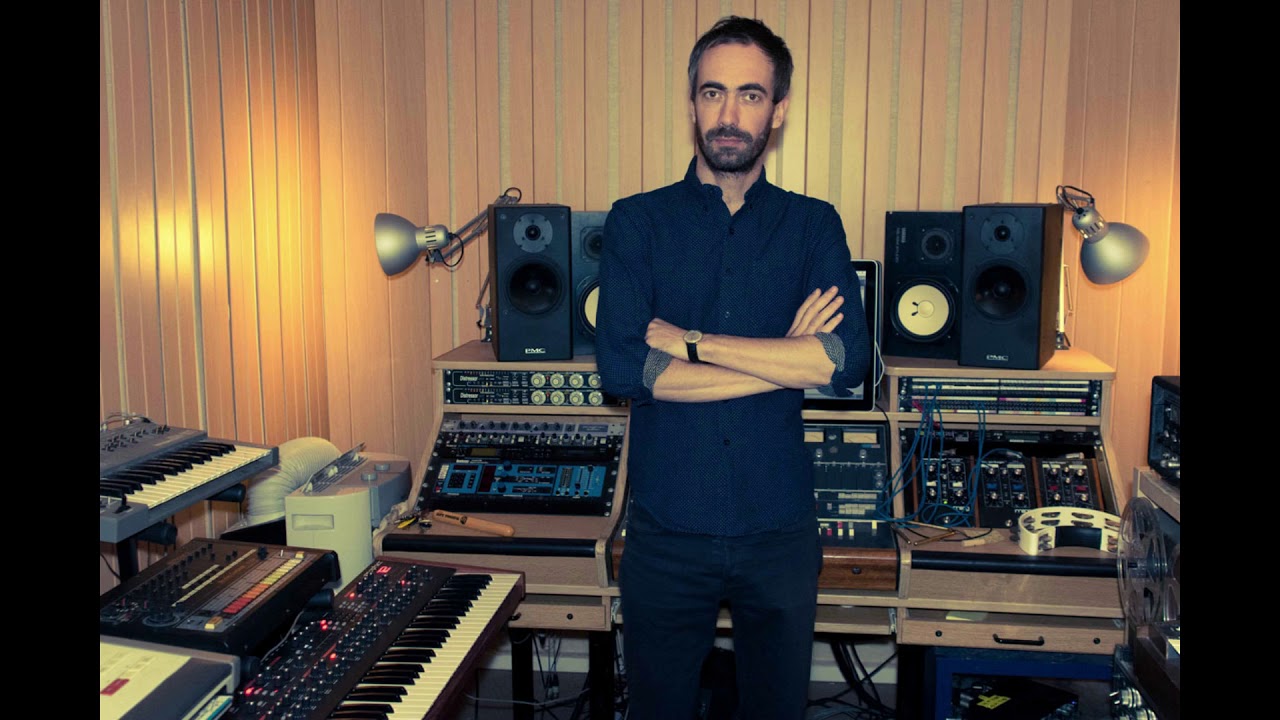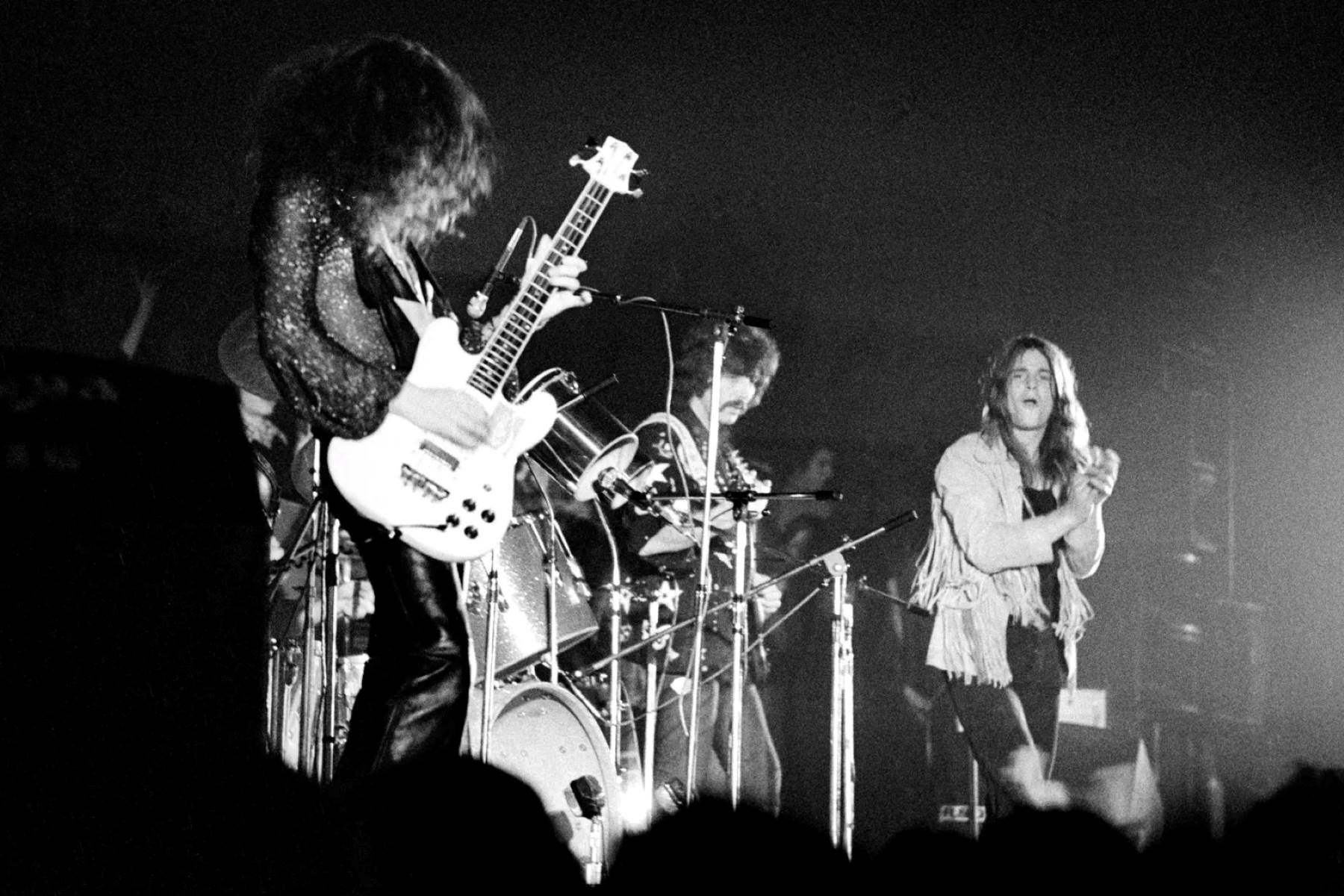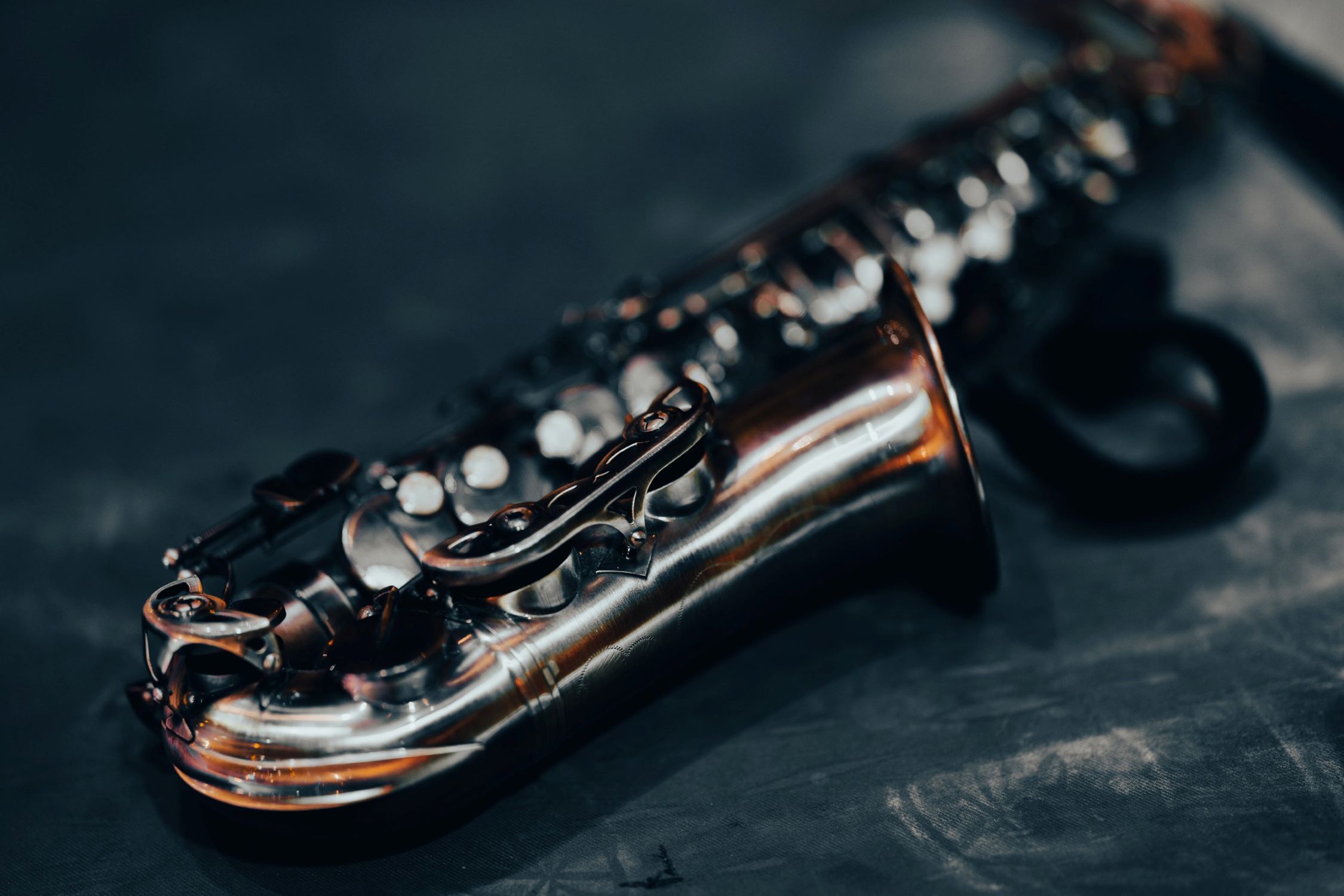Home>Genres>Jazz>Why Was Jazz Considered An American Art Form
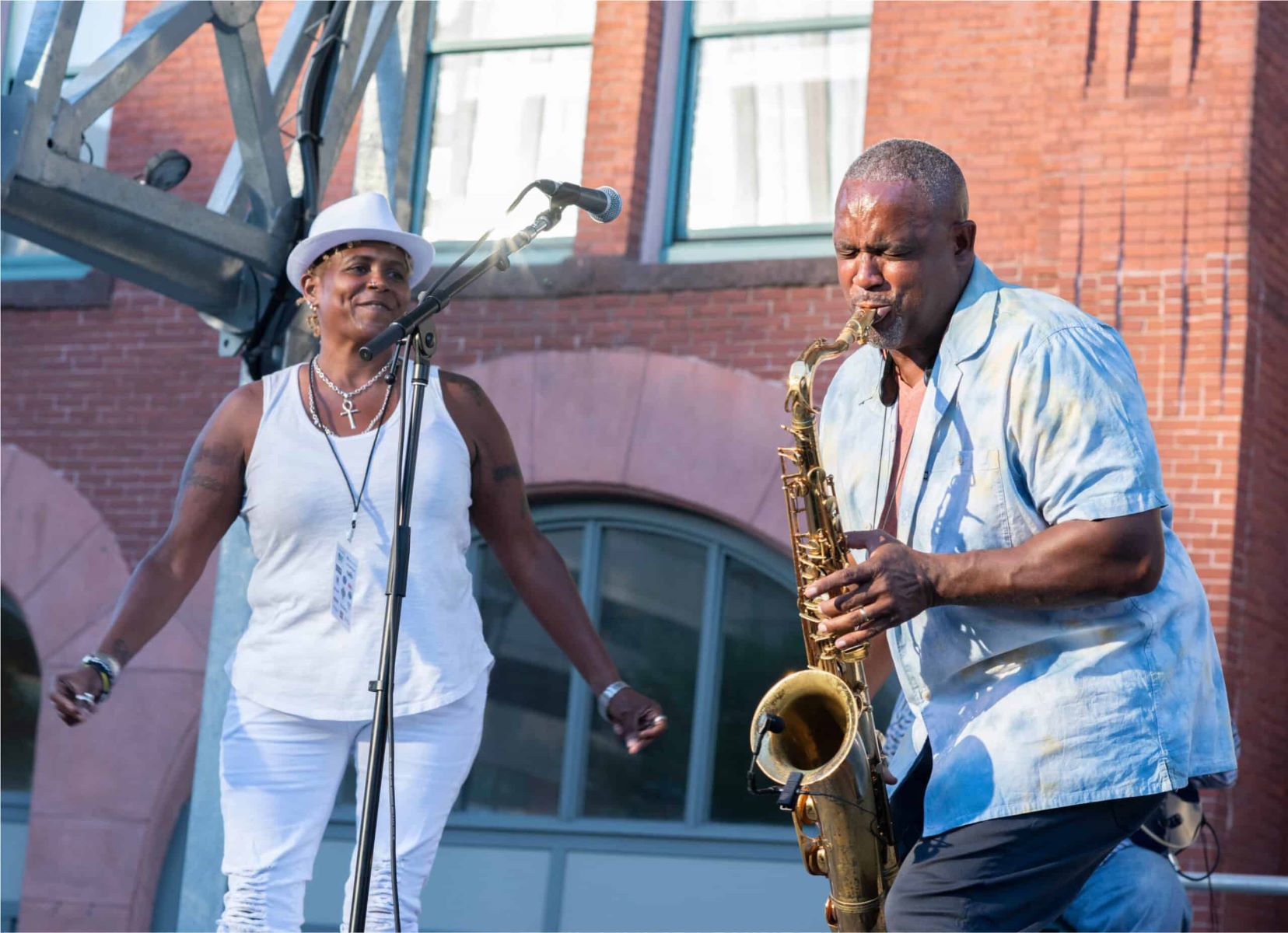

Jazz
Why Was Jazz Considered An American Art Form
Modified: February 24, 2024
Discover the origins and significance of Jazz as an iconic American art form. Explore its cultural impact and influential artists that shaped its evolution.
(Many of the links in this article redirect to a specific reviewed product. Your purchase of these products through affiliate links helps to generate commission for AudioLover.com, at no extra cost. Learn more)
Table of Contents
Introduction
Jazz is a genre of music that originated in the early 20th century and has since become one of America’s most significant cultural contributions to the world. Its origins can be traced back to African-American communities in New Orleans, Louisiana, but it quickly spread across the country, captivating people with its unique rhythms, improvisation, and soulful melodies.
The development of jazz was deeply influenced by the cultural and musical traditions of African Americans, who infused their heritage into the music, creating a distinct style that would come to symbolize the spirit and history of an entire nation. Jazz was not just a musical genre; it was an expression of the African-American experience and a reflection of the struggles and triumphs of a marginalized community.
With its roots in African musical traditions, work songs, spirituals, and the blues, jazz transformed into a vibrant art form that broke free from traditional musical structures. It allowed for improvisation, where musicians could showcase their individual skills and creativity through spontaneous musical dialogue with their fellow performers. It was this freedom of expression that made jazz a truly distinctive and groundbreaking genre.
As jazz spread across America, it began to evolve and incorporate various regional styles and influences. From the hot jazz of Louis Armstrong to the smooth sounds of Duke Ellington’s big band, jazz became a universal language that transcended cultural barriers and connected people from all walks of life. In the early 20th century, the Harlem Renaissance further propelled jazz into the mainstream, as African-American artists and musicians found a platform to showcase their talent and creativity.
The advent of radio in the 1920s provided jazz with a wider audience and allowed it to reach homes across America. The swing era of the 1930s and 1940s brought jazz further into the limelight, with big bands and dance halls becoming the hubs of this energetic and infectious music. Jazz had become both a musical phenomenon and a cultural movement that shaped American society.
In this article, we will delve into the origins of jazz, the influences of African-American music, the role of African-American musicians in shaping the genre, and the various styles and eras of jazz. We will explore how jazz spread across America, its impact on the Harlem Renaissance, and its association with the radio and swing eras. By the end, you will have a deeper understanding of why jazz is considered an American art form and its profound cultural significance.
Origins of Jazz
The origins of jazz can be traced back to the early 20th century in New Orleans, Louisiana. It emerged from a melting pot of musical influences, including African rhythms, European harmonies, and American popular music. The city’s multicultural atmosphere provided the perfect breeding ground for a new and innovative musical genre.
African musical traditions played a crucial role in the development of jazz. Enslaved Africans brought their vibrant rhythms and musical customs to America, blending them with the European musical traditions they encountered. This fusion of African and European musical elements laid the foundation for what would become jazz.
In New Orleans, a unique musical culture began to take shape. African Americans and Creoles, descendants of French and Spanish colonizers, intermingled and shared their musical traditions. The city’s diverse population brought together diverse influences, such as blues, ragtime, spirituals, brass band music, and the syncopated rhythms of Caribbean music.
The distinctive New Orleans sound can be heard in the music of early jazz pioneers such as Buddy Bolden, Jelly Roll Morton, and Louis Armstrong. These musicians incorporated improvisation, syncopation, and call-and-response patterns into their performances, creating a dynamic and exciting new style of music.
The birth of jazz is often linked to the rise of the jazz funeral tradition in New Orleans. These celebrations of life and death featured brass bands playing sorrowful dirges on the way to the cemetery and joyous, upbeat music on the way back. This juxtaposition of mournful and celebratory music captures the essence of jazz – a genre that conveys a range of emotions and tells stories through music.
While New Orleans is recognized as the birthplace of jazz, it quickly spread to other cities like Chicago and New York, where it continued to evolve and gain popularity. The early pioneers of jazz paved the way for future generations of musicians to explore new possibilities in improvisation, instrumentation, and composition.
In summary, the origins of jazz can be traced back to the rich musical heritage of New Orleans, where African rhythms, European harmonies, and American popular music merged to create a unique and groundbreaking genre. The multicultural influences and vibrant musical traditions shaped the evolution of jazz and laid the groundwork for its status as a truly American art form.
Influences of African-American Music
African-American music has had a profound impact on the development and evolution of jazz. From the spirituals and work songs of enslaved Africans to the blues and ragtime, the musical traditions of African Americans have provided the foundation for this iconic American art form.
One of the primary influences on jazz is the blues. Originating in the Deep South among African Americans, the blues emerged as a powerful expression of emotions and experiences. Its characteristic 12-bar chord progression, soulful vocals, and lyrical themes of love, loss, and adversity became an integral part of jazz. Musicians like Bessie Smith, Ma Rainey, and Robert Johnson brought the blues to national attention, and their influence can be heard in the improvisational and emotional aspects of jazz.
Another significant influence on jazz is the rhythmic complexity of African music. African drumming techniques, polyrhythms, and syncopation found their way into jazz, giving it its infectious and distinctive groove. Musicians like Art Blakey and Max Roach incorporated African-inspired rhythms into their playing, further enhancing the rhythmic aspect of jazz.
Furthermore, the call-and-response tradition in African music has heavily influenced jazz. This musical dialogue between different instruments or voices is a fundamental element of jazz improvisation. Jazz musicians draw inspiration from the call-and-response tradition to create dynamic and interactive performances, where ideas are passed back and forth, creating a musical conversation.
In addition to the blues and African rhythms, spirituals and gospel music have also left their mark on jazz. Spirituals, rooted in the African-American church, showcase powerful vocals and emotional delivery. Gospel music, with its joyful and exuberant sound, brought elements of improvisation, call-and-response, and deep devotion into the world of jazz. Musicians like Mahalia Jackson and Ray Charles seamlessly blended the spiritual and gospel influences into their jazz performances.
The influence of African-American music on jazz cannot be overstated. It is these deep-rooted musical traditions that gave jazz its soul, its expressive power, and its ability to transcend cultural boundaries. Jazz became a vehicle for African Americans to tell their stories, express their emotions, and assert their cultural identity, ultimately helping to shape the sound and spirit of America.
Role of African-American Musicians
African-American musicians have played an indispensable role in the development and advancement of jazz. Their immense talent, creativity, and determination have not only shaped the genre but also challenged racial barriers and catalyzed social change. Through their contributions, African-American musicians have transformed jazz into a powerful symbol of resilience, cultural identity, and artistic excellence.
During the early days of jazz, African-American musicians faced significant prejudice and segregation. Despite these challenges, they persevered, using their music as a means of expression and empowerment. It was their innovative spirit and cultural heritage that infused jazz with its distinctive sound and character.
One of the most influential African-American musicians in jazz history is Louis Armstrong. As a cornet and trumpet player, Armstrong revolutionized jazz with his technical proficiency, unique vocal style, and improvisational genius. His virtuosity and charismatic stage presence brought jazz to new heights, inspiring generations of musicians to explore their own musical boundaries.
The influence of African-American musicians extended beyond their instrumental or vocal skills. They were also primary contributors to the genre’s compositional and arranging aspect. Figures such as Duke Ellington and Count Basie not only led their own big bands but also composed and arranged groundbreaking compositions that became jazz standards. Their compositions showcased sophistication, innovation, and a deep understanding of the African-American musical tradition, pushing jazz into uncharted territory.
African-American musicians also acted as cultural ambassadors, bringing the rich heritage of jazz to audiences worldwide. Their performances captivated listeners and broke down racial boundaries. Jazz became a vehicle for cross-cultural dialogue, fostering understanding and appreciation of African-American culture and its contributions to the American musical landscape.
Furthermore, African-American musicians forged paths for future generations by actively participating in the civil rights movement. They used their platforms to advocate for equality and social justice. Artists like Nina Simone and Charles Mingus created music that reflected the struggles and aspirations of the African-American community, amplifying their voices and demanding change.
Today, African-American musicians continue to push the boundaries of jazz, showcasing their talent and creativity in various subgenres and styles. Their contributions not only keep the music alive but also redefine and reshape the genre, ensuring that jazz remains relevant and continues to evolve.
In essence, African-American musicians have been instrumental in shaping jazz into a unique and profound art form. Their invaluable contributions have left an indelible mark on the genre’s history, sound, and cultural significance, making jazz a testament to the creativity, resilience, and cultural heritage of African Americans.
Early Jazz Styles
During its early years, jazz underwent various stylistic developments, reflecting the diverse musical influences and cultural contexts in which it evolved. From the exuberant sounds of New Orleans to the sophisticated arrangements of the big bands, early jazz styles encompassed a range of musical expressions.
One of the earliest forms of jazz was Dixieland, also known as New Orleans jazz. Emerging in the early 20th century, Dixieland jazz featured small bands with an ensemble of instruments including trumpet, clarinet, trombone, piano, banjo, and drums. Improvisation was a central element in Dixieland, with musicians taking turns soloing while the rest of the band provided rhythmic accompaniment.
As jazz spread beyond New Orleans, its style began to evolve. Hard bop and bebop emerged in the 1940s as a response to the commercialization of jazz. Hard bop emphasized a return to blues, gospel, and R&B roots. It featured complex harmonies, intricate improvisation, and strong rhythms. Bebop, on the other hand, was characterized by fast tempos, complex melodies, and extended improvisation. Musicians like Charlie Parker and Dizzy Gillespie were central to the development of these styles.
Another prominent early jazz style was swing. The swing era, also known as the big band era, spanned from the 1930s to the 1940s. Swing music was characterized by its upbeat and danceable rhythms, complex arrangements, and a strong emphasis on improvisation. Big bands, led by legendary figures such as Duke Ellington, Count Basie, and Benny Goodman, became popular and showcased the talents of many individual musicians through solos and ensemble playing.
Within swing, sub-genres such as Kansas City jazz and West Coast jazz emerged. Kansas City jazz had a more bluesy and spontaneous feel, characterized by hard-driving rhythms and spirited improvisation. It was popularized by bands like Count Basie’s Orchestra. West Coast jazz, on the other hand, had a cooler and more laid-back vibe, with intricate arrangements and a focus on inventive improvisation. Artists like Chet Baker and Gerry Mulligan were key figures in West Coast jazz.
Early jazz also saw the rise of Latin jazz, which blended Afro-Cuban rhythms and Latin American musical elements with jazz improvisation. Artists like Dizzy Gillespie and Machito were at the forefront of this genre, fusing the infectious rhythms of Latin music with the harmonic and melodic complexities of jazz.
In summary, early jazz styles encompassed a range of expressions, from the exuberant sounds of Dixieland and the sophisticated arrangements of swing to the complex harmonies of hard bop and the fusion of Latin rhythms in Latin jazz. These styles laid the foundation for further developments in jazz and have remained influential throughout its history.
Jazz Spreads Across America
After its beginnings in New Orleans, jazz quickly spread across America, captivating audiences with its infectious rhythms and innovative sounds. The migration of African Americans from the South to other parts of the country played a significant role in the dissemination of jazz, bringing the music to new audiences and influencing regional styles.
One of the key cities where jazz took hold was Chicago. In the 1920s, Chicago became a hub for jazz musicians and the birthplace of Chicago-style jazz. Artists like King Oliver, Louis Armstrong, and Earl Hines contributed to the city’s vibrant jazz scene, creating a unique sound characterized by bold improvisation, energetic rhythms, and expressive solos. Chicago-style jazz became immensely popular and influenced jazz musicians nationwide.
New York City also played a pivotal role in the spread of jazz. As the cultural capital of the United States, New York became a magnet for jazz musicians seeking opportunities and exposure. The Harlem neighborhood in particular became a center of jazz during the Harlem Renaissance in the 1920s. Legendary venues like the Cotton Club and the Apollo Theater showcased performances by jazz icons like Duke Ellington, Cab Calloway, and Ella Fitzgerald. The influence of Harlem jazz extended beyond the neighborhood, shaping the broader jazz landscape and inspiring musicians across the country.
Along with Chicago and New York, other cities such as Kansas City, St. Louis, and Los Angeles played significant roles in jazz’s spread. Kansas City, in particular, became known for its distinctive style characterized by a balance between elegant arrangements and lively improvisation. Musicians like Count Basie and Charlie Parker emerged from the Kansas City jazz scene, contributing to the city’s rich jazz legacy.
The popularity of jazz was further aided by the advent of new technologies, such as recordings and radio. With the rise of phonograph records, jazz recordings became widely accessible, allowing people from different regions of the country to experience the music. Radio broadcasts also played a crucial role in spreading jazz to a broader audience. The radio era of the 1920s brought live jazz performances into people’s homes, making jazz a part of everyday life and fueling its popularity across America.
As jazz spread across the country, it adapted and merged with various regional musical traditions and styles. Regional jazz scenes developed their own distinctive sounds, incorporating local influences and expanding the boundaries of the genre. From the blues-infused sounds of the Mississippi Delta to the Latin rhythms of the West Coast, jazz became a versatile and ever-evolving art form that reflected the diversity of America.
In summary, jazz’s journey across America was fueled by the migration of African Americans, cultural hotspots like Chicago and New York City, technological advancements in recording and radio, and the merging of regional musical traditions. The spread of jazz allowed it to reach new audiences, influence local styles, and solidify its position as a significant cultural force in America.
Jazz and the Harlem Renaissance
The Harlem Renaissance, a cultural and intellectual movement that took place in the 1920s, played a pivotal role in the development and popularization of jazz. This vibrant period in African-American history saw a flourishing of art, literature, music, and intellectual discourse, with Harlem, a neighborhood in New York City, serving as its epicenter.
During the Harlem Renaissance, jazz became a symbol of cultural pride and artistic expression for African Americans. The movement provided an opportunity for African-American musicians to showcase their talent and gain recognition as innovators in the jazz world. Iconic jazz figures such as Duke Ellington, Louis Armstrong, and Bessie Smith emerged during this period, leaving an indelible mark on the genre.
The Harlem Renaissance also fostered a sense of community and collaboration among artists. Musicians and other creative individuals gathered in jazz clubs, speakeasies, and other venues, exchanging ideas and inspirations. The vibrant atmosphere of Harlem nurtured a spirit of experimentation and artistic freedom, which resulted in some of the most influential and groundbreaking jazz recordings of the time.
In addition to their musical contributions, jazz musicians of the Harlem Renaissance played a significant role in challenging racial stereotypes and breaking down barriers. Through their performances and recordings, they showcased the immense talent and creativity of African-American artists, challenging mainstream perceptions and inspiring pride within their communities.
One of the key establishments that became synonymous with the Harlem Renaissance and jazz was the Cotton Club. This famous nightclub featured performances by jazz luminaries such as Duke Ellington and Cab Calloway. The club, although segregated, became a symbol of achievement and sophistication within the Harlem community, as well as a stage for African-American musicians to collaborate and showcase their artistry to a wider audience.
The impact of the Harlem Renaissance extended beyond New York City and influenced the broader jazz landscape. The music and spirit of the movement resonated with artists and enthusiasts across the country, leading to the spread and popularization of jazz as an integral part of American culture.
The legacy of the Harlem Renaissance continues to shape our understanding of jazz today. Its emphasis on artistic expression, cultural identity, and social commentary set the stage for future generations of jazz musicians to explore new boundaries and redefine the genre. The innovations and achievements of the jazz artists during this period laid the groundwork for jazz to become a lasting and important cultural movement in America.
Jazz and the Radio Era
The radio era, which began in the 1920s, had a profound impact on the popularity and dissemination of jazz. The radio brought jazz music into the homes of millions of Americans, providing a platform for the genre to reach a wider audience and solidify its status as a significant cultural force.
Before the advent of radio, jazz primarily thrived in live performances and recordings. However, radio broadcasts allowed jazz to be heard by people who may not have had access to live performances or recordings. This increased accessibility introduced jazz to new audiences and helped shape its identity as a genre that could be enjoyed by anyone, regardless of their location or socio-economic status.
The radio era also provided a platform for jazz musicians to gain exposure and recognition. Jazz bands and orchestras were invited to perform live on radio programs, allowing listeners to experience the energy and excitement of a live jazz performance from the comfort of their homes. Jazz musicians like Duke Ellington, Louis Armstrong, and Benny Goodman became household names through their radio appearances, and their music reached a national audience.
Radio broadcasts also played a significant role in breaking down racial barriers in the world of music. Jazz, as a predominantly African-American genre, had often faced obstacles due to racial segregation. However, the radio era allowed jazz to transcend racial boundaries, reaching a broad and diverse audience. This exposure helped challenge stereotypes and prejudices, as listeners began to appreciate the remarkable talents of African-American jazz musicians.
The radio era also allowed for the dissemination of different styles and subgenres of jazz. Programmers and disc jockeys introduced listeners to everything from the mainstream big band sound to innovative forms like bebop and cool jazz. This exposure to a variety of jazz styles helped fuel the genre’s evolution and encouraged musicians to push creative boundaries.
Radio broadcasting was not only limited to commercial stations. Pirate radio stations and amateur radio operators played a crucial role in promoting jazz, especially in communities underserved by mainstream radio. These independent stations provided a platform for local jazz musicians to showcase their talent and share their music with their communities.
In summary, the radio era played a transformative role in the development and popularization of jazz. It provided a means of widespread exposure for jazz music, introduced new audiences to the genre, helped break down racial barriers, and showcased the diversity and evolution of jazz styles. The impact of radio on jazz cannot be overstated, as it allowed the genre to transcend limitations and cement its status as a vital part of American cultural heritage.
Jazz and the Swing Era
The swing era, spanning from the 1930s to the 1940s, was a golden age for jazz. This period saw the rise of big bands, energetic dance halls, and a sense of optimism amidst the challenges of the Great Depression. The swing era not only solidified jazz as a mainstream musical form but also provided a platform for some of the most iconic jazz musicians in history.
Swing music, characterized by its lively rhythms, catchy melodies, and intricate arrangements, became the soundtrack of the era. The driving force behind the sound of the swing era was the big bands, led by legendary figures such as Duke Ellington, Count Basie, Benny Goodman, and Glenn Miller. These orchestras featured sections of saxophones, trumpets, trombones, and a rhythm section, producing a rich and vibrant sound that inspired people to dance and celebrate.
The popularity of swing was closely tied to the dance craze of the time. The infectious rhythms and energetic feel of swing music provided the perfect backdrop for social dancing, with iconic dances like the Lindy Hop and the Jitterbug becoming wildly popular. Swing dance halls, like the Savoy Ballroom in Harlem, were pulsating with the joy and jubilation of people dancing to the swinging sounds of jazz.
One of the defining characteristics of the swing era was the emphasis on improvisation and solo performances. Within the structured arrangements played by the big bands, individual musicians were given opportunities to shine through their solos. Legendary soloists like saxophonist Coleman Hawkins, clarinetist Benny Goodman, and trumpeter Louis Armstrong pushed the boundaries of improvisation, captivating audiences with their virtuosity and creativity.
The swing era was also significant in breaking down racial barriers in jazz. Big bands led by white musicians like Benny Goodman and Glenn Miller regularly featured African-American musicians in their ensembles, providing a platform for them to showcase their talent and collaboration. This integration, although not without challenges and racial tensions, helped challenge racial prejudices and contributed to the gradual breakdown of segregation in the jazz world.
The swing era eventually came to an end with the onset of World War II. Economic and logistical challenges caused many big bands to disband, and the focus of the nation shifted to the war effort. However, the impact of the swing era on jazz and popular music persevered. Its energetic spirit and catchy melodies continue to resonate with audiences today, and the innovations of the era laid the foundation for future developments in jazz.
In summary, the swing era was a pivotal period in jazz history. It brought jazz into the mainstream, showcased the talents of legendary musicians, and provided a platform for social dancing and celebration. The swing era’s enduring legacy can still be felt today, as its music continues to inspire and uplift audiences around the world.
Jazz as an American Cultural Movement
Jazz is not just a genre of music; it is also a cultural movement that has had a profound impact on American society and beyond. From its origins in the African-American communities of New Orleans to its evolution as a global phenomenon, jazz has played a pivotal role in shaping American culture and identity.
One of the defining characteristics of jazz as a cultural movement is its ability to transcend boundaries and bring people together. Jazz has always been a music of collaboration and improvisation, with musicians from diverse backgrounds coming together to create something new and vibrant. This spirit of collaboration and creative exchange reflects the multicultural fabric of America, showcasing the power of unity and cooperation in a society marked by diversity.
Jazz has also been an agent of social change, challenging societal norms and advocating for equality and justice. In its early years, jazz was a music born out of the African-American experience, expressing the joys, sorrows, and struggles of a marginalized community. African-American jazz musicians like Louis Armstrong, Ella Fitzgerald, and Billie Holiday used their music to confront racism, prejudice, and social injustices, becoming cultural icons and inspiring generations to break down barriers.
The cultural influence of jazz expanded during the Harlem Renaissance, a period in the 1920s when African-American artists flourished in Harlem, New York. Jazz became a symbol of African-American excellence and creativity, providing a platform for artists to express their cultural identity and challenge the prevailing narratives of the time. The impact of the Harlem Renaissance extended beyond the realm of music, permeating literature, visual arts, dance, and intellectual discourse.
As jazz spread across America and gained international recognition, it became a symbol of American freedom, innovation, and individualism. Jazz’s emphasis on improvisation and individual expression reflected the country’s core values of personal liberty and creativity. It represented the vibrancy and dynamism of American society and its capacity for cultural fusion and reinvention.
Moreover, jazz has influenced and shaped other art forms, including literature, film, and visual arts. The improvisational nature of jazz has inspired writers to experiment with storytelling techniques, while its emotional depth and spontaneity have informed cinematography and visual aesthetics. Jazz has become a source of inspiration for artists across different disciplines, fostering cross-cultural dialogues and artistic collaborations that continue to redefine the boundaries of creativity.
Today, jazz remains a vital part of American culture, as well as a global phenomenon. It continues to evolve, incorporating new influences and embracing diverse musical styles. Jazz festivals, educational programs, and dedicated jazz venues keep the music alive and thriving. By celebrating jazz, we celebrate the spirit of American innovation, diversity, and cultural exchange.
In summary, jazz is not just a genre of music but a cultural movement that has shaped and reflected the evolving identity of America. It brings people together, challenges social norms, and serves as a platform for artistic expression, social commentary, and cultural exchange. As an American cultural movement, jazz continues to inspire, unite, and transform communities, making it a truly significant and enduring part of our cultural fabric.
Conclusion
Jazz is more than just a genre of music; it is a cultural phenomenon that has left an indelible mark on American society and beyond. With its origins rooted in the African-American communities of New Orleans, jazz has evolved into a powerful and influential art form that reflects the diverse cultural heritage of America.
From the bluesy sounds of Dixieland to the energetic rhythms of swing, jazz has embraced various styles and subgenres, constantly reinventing itself while staying true to its roots. The influences of African-American music, the role of African-American musicians, and the cultural movements like the Harlem Renaissance have all played a significant role in shaping and expanding the reach of jazz.
The radio era and the swing era brought jazz into the mainstream, allowing it to be enjoyed by a wider audience and solidifying its status as an American cultural treasure. Jazz not only provided a platform for artistic expression and innovation but also acted as a vehicle for social change, challenging racial barriers and promoting equality.
Jazz as a cultural movement embodies the values of collaboration, creativity, and individuality that define America’s cultural landscape. It has inspired artists across various disciplines, influencing literature, film, and visual arts. Jazz festivals, educational programs, and dedicated venues continue to keep the spirit of jazz alive, ensuring its legacy for future generations.
In conclusion, jazz is a testament to the power of music and the profound influence it can have on a society. It is an embodiment of the American spirit, reflecting the nation’s history, diversity, resilience, and artistic excellence. Jazz has not only enriched the musical landscape but also contributed to social progress and cultural exchange. Its impact and legacy as an American art form continue to resonate, reminding us of the transformative power of music and the enduring cultural significance of jazz.

